The goal of Will the world save beauty? – Prevention and safety for the protection of cultural heritage is to highlight and reflect on how the potential of beauty, intended as the best of artistic and spiritual production, can prove to be the only ‘weapon’ useful for saving our life and satisfying a social desire for beauty. The exhibition opened on Monday 12th July and was organised by the European Centre for Tourism and Culture in Rome, directed by Giuseppe Lepore, in synergy with the General Directorate for the Safety of Cultural Heritage of the Ministry of Culture, the Carabinieri Command for the Protection of Cultural Heritage (T.P.C.) and the National Museum of Castel Sant’Angelo. “In such a particular and delicate moment – explained the organisers – in which the whole world is coexisting with a pandemic and looking for tools to be able to win this ‘invisible war’, it seems necessary for beauty to save the world. But can we safeguard this precious asset? And how do we secure this immense heritage, of which we are custodians, in order to be able to pass it on to the future? Revisiting this concept, we’ve asked ourselves: will the world save beauty?”. From this question came the idea of creating the exhibition at the National Museum of Castel Sant’Angelo curated by Vincenzo Lemmo, which wants to be not only a display of finds recovered by the Carabinieri Command for the Protection of Cultural Heritage, directed by Brigadier General Roberto Riccardi, for years at the forefront in the defence of our historical and artistic treasures, but also a presentation of the prevention and protection systems adopted by state-owned museums and places of culture under the coordination of the General Directorate for the Safety of Cultural Heritage of the Ministry of Culture, directed by Marica Mercalli.
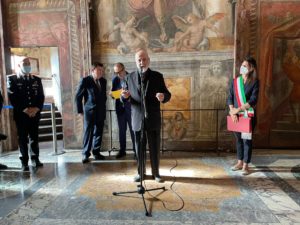
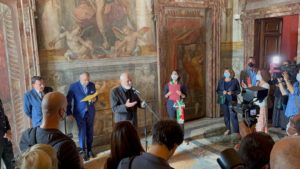
Michelangelo Pistoletto’s speech.
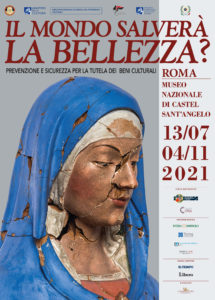
The poster of the exhibition.
The exhibition project is divided into different sections, within which visitors are led to the discovery of stories of recovery, preservation and protection presented through narratives and images. “The choice of the material on display, which includes important works attributed to artists like Brueghel and Veronese and fascinating finds like a fragment of the obelisk located in Montecitorio, the result of the work carried out by the Carabinieri T.P.C., – specifies a dedicated press note – reflects precisely this idea of narration”. As mentioned, a section focuses in fact on the recovery of cultural heritage assets and the investigations that have allowed the return of illegally stolen objects and their subsequent safety. The organisers have also mentioned that the exhibition highlights how today the world of the web represents a channel for the dissemination and sale of these objects, but also an ally in their defence by contrasting illicit trafficking thanks to the creation of databases.

Pistoletto and Virginia Raggi with the mirror painting.

Brigadier General Roberto Riccardi and Michelangelo Pistoletto.
“Saving art – reads the press release of the exhibition – also means saving the integrity of our treasures, not allowing them to leave the national borders. This difficult job is carried out with constant commitment by the Export Offices of the Ministry of Culture which, in close collaboration with the Carabinieri, control the movement and sale of art objects, preventing a tragic cultural haemorrhage. In this case too, the use of web platforms, the creation of databases and the continuous monitoring of national and international auctions play a very important role. Protecting art and its beauty therefore means intervening in emergency scenarios where safeguarding the works becomes urgent and delicate”. The exhibition also strives to make the stories and the message of hope accessible to all visitors: the display is in fact enriched by panels and captions in Braille and by embossed reproductions of works for the blind. “By analysing the different aspects presented in the exhibition, – the organisers observed – it can be concluded that the world, our civil society, will save the beauty contained in our artistic and cultural assets, symbols of our identity”.
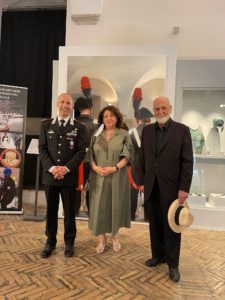
Brigadier General Roberto Riccardi, Mariastella Margozzi (director of the National Museum of Castel Sant’Angelo) and Michelangelo Pistoletto.
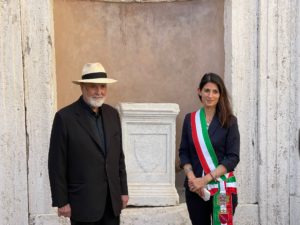
Pistoletto and Virginia Raggi.
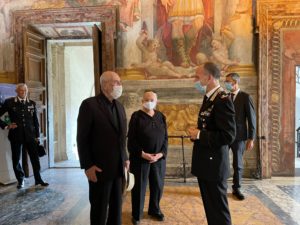
Pistoletto and Maria Pioppi with Brigadier General Roberto Riccardi.
Yesterday’s opening of the exhibition Will the world save beauty? saw the participation of the Minister of Culture Dario Franceschini and the mayor of Rome Virginia Raggi – who also thanked Pistoletto for the project 100 benches for Rome and for the inspiration and vision of the symbol of the Third Paradise – to validate the socio-cultural importance of the event. Also in attendance was Michelangelo Pistoletto, who created a work for the exhibition: the mirror painting Carabinieri. The artist from Biella introduced his work, part of the exhibition, by saying: “I am very happy to be present with my painting in this wonderful venue. I think that in this context my work is particularly significant: it is a mirror painting in which the subjects are two Carabinieri, a man and a woman, therefore conveying the idea of duality. The latter gives meaning to this work, in which we present ourselves as participants and representatives of all the differences that exist in the world. Over time, I hope, the world will parade in front of this work, and in this instance – concluded Pistoletto – the corps of the Carabinieri functions as a mediator of human relationships”. The work Carabinieri, dedicated to the corps, will find its definitive location within the Historical Museum of the Carabinieri. The exhibition is open from Tuesday to Sunday from 9:00 to 19.30 (last admission at 18.30); the entrance ticket is € 12 (concessions € 2). For information: +39 06 32810.

